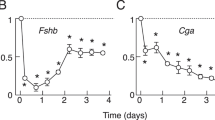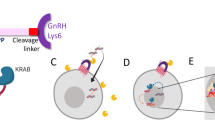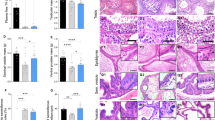Abstract
One of the challenges of gene targeting is to achieve regulated transgene expression in specific target cells. The hypogonadal (hpg) mice are genetically deficient in hypothalamic gonadotropin-releasing hormone (GnRH) production due to a deletion in the GnRH gene, resulting in hypogonadotropic hypogonadism. Here we show an improvement in reproductive parameters of adult female homozygous hpg mice by direct infusion into the hypothalamic preoptic area (POA) of a herpes simplex virus (HSV)-based amplicon vector containing a 13.5 kb genomic fragment encoding the GnRH gene together with its cognate promoter and regulatory elements. Following vector injection, GnRH-expressing neurons were detected in the POA, and pituitary and plasma gonadotropin levels as well as ovarian and uterine weights increased. In addition, a subset of injected hpg mice demonstrated cyclic estrous changes, consistent with regulated control of GnRH production. Administration of kisspeptin-10 resulted in an increase in plasma luteinizing hormone levels, further supporting appropriate regulation of the introduced GnRH transgene. These findings indicate that delivery of the GnRH gene resulted in selective neuronal expression of GnRH and regulated hypothalamic GnRH release. To our knowledge, this is the first example of the correct targeting of a gene under its cognate promoter to neurons resulting in selective and regulated synthesis of a biologically active peptide, and thus may have a wide range of applications in the treatment of human disorders.
This is a preview of subscription content, access via your institution
Access options
Subscribe to this journal
Receive 12 print issues and online access
$259.00 per year
only $21.58 per issue
Buy this article
- Purchase on Springer Link
- Instant access to full article PDF
Prices may be subject to local taxes which are calculated during checkout






Similar content being viewed by others
References
Bensadoun J-C, Déglon N, Tseng JL, Ridet J-L, Zurn AD, Aebischer P . Lentiviral vectors as a gene delivery system in the mouse midbrain: cellular and behavioral improvements in a 6-OHDA model of Parkinson's disease using GDNF. Exp Neurol 2000; 164: 15–24.
Davidson BL, Breakefield XO . Viral vectors for gene delivery to the nervous system. Nat Rev Neurosci 2003; 4: 353–364.
Yoshimura S, Teramoto T, Whalen MJ, Irizarry MC, Takagi Y, Qiu J et al. FGF-2 regulates neurogenesis and degeneration in the dentate gyrus after traumatic brain injury in mice. J Clin Invest 2003; 112: 1202–1210.
Bloch J, Bachoud-Levi AC, Déglon N, Lefaucheur JP, Winkel L, Palfi S et al. Neuroprotective gene therapy for Huntington's disease, using polymer-encapsulated cells engineered to secrete human ciliary neurotrophic factor: results of a phase I study. Hum Gene Ther 2004; 15: 968–975.
Tuszynski MH, Thal L, Pay M, Salmon DP, U HS, Bakay R et al. A phase 1 clinical trial of nerve growth factor gene therapy for Alzheimer disease. Nat Med 2005; 11: 551–555.
Schiedner G, Morral N, Parks RJ, Wu Y, Koopmans SC, Langston C et al. Genomic DNA transfer with a high-capacity adenovirus vector results in improved in vivo gene expression and decreased toxicity. Nat Genet 1998; 18: 180–183.
Davis JRE, McVerry J, Lincoln GA, Windeatt S, Lowenstein PR, Castro MG et al. Cell type-specific adenoviral transgene expression in the intact ovine pituitary gland after stereotaxic delivery: an in vivo system for long-term multiple parameter evaluation of human pituitary gene therapy. Endocrinology 2001; 142: 795–801.
Kilic E, Hermann DM, Kügler S, Kilic U, Holzmüller H, Schmeer C et al. Adenovirus-mediated Bcl-XL expression using a neuron-specific synapsin-1 promoter protects against disseminated neuronal injury and brain infarction following focal cerebral ischemia in mice. Neurobiol Dis 2002; 11: 275–284.
Jakobsson J, Ericson C, Jansson M, Björk E, Lundberg C . Targeted transgene expression in rat brain using lentiviral vectors. J Neurosci Res 2003; 73: 876–885.
Do Thi NA, Saillour P, Ferrero L, Dedieu JF, Mallet J, Paunio T . Delivery of GDNF by an E1,E3/E4 deleted adenoviral vector and driven by a GFAP promoter prevents dopaminergic neuron degeneration in a rat model of Parkinson's disease. Gene Therapy 2004; 11: 746–756.
Oehmig A, Fraefel C, Breakefield XO . Update on herpesvirus amplicon vectors. Mol Ther 2004; 10: 630–643.
Senior SL, Wade-Martins R . Herpes simplex virus type 1 amplicon vectors for the infectious delivery and expression of genomic DNA loci. Curr Opin Mol Ther 2005; 7: 337–345.
Fraefel C, Song S, Lim F, Lang P, Yu L, Wang Y et al. Helper virus-free transfer of herpes simplex virus type 1 plasmid vectors into neural cells. J Virol 1996; 70: 7190–7197.
Saeki Y, Fraefel C, Ichikawa T, Breakefield XO, Chiocca EA . Improved helper virus-free packaging system for HSV amplicon vectors using an ICP27-deleted, oversized HSV-1 DNA in a bacterial artificial chromosome. Mol Ther 2001; 3: 591–601.
Sandler VM, Wang S, Angelo K, Lo HG, Breakefield XO, Clapham DE . Modified herpes simplex virus delivery of enhanced GFP into the central nervous system. J Neurosci Methods 2002; 121: 211–219.
Bowers WJ, Olschowka JA, Federoff HJ . Immune responses to replication-defective HSV-1 type vectors within the CNS: implications for gene therapy. Gene Therapy 2003; 10: 941–945.
Wade-Martins R, Saeki Y, Chiocca EA . Infectious delivery of a 135-kb LDLR genomic locus leads to regulated complementation of low-density lipoprotein receptor deficiency in human cells. Mol Ther 2003; 7: 604–612.
Inoue R, Moghaddam KA, Ranasinghe M, Saeki Y, Chiocca EA, Wade-Martins R . Infectious delivery of the 132 kb CDKN2A/CDKN2B genomic DNA region results in correctly spliced gene expression and growth suppression in glioma cells. Gene Therapy 2004; 11: 1195–1204.
Silverman A-J, Jhamandas J, Renaud LP . Localization of luteinizing hormone-releasing hormone (LHRH) neurons that project to the median eminence. J Neurosci 1987; 7: 2312–2319.
Cattanach BM, Iddon CA, Charlton HM, Chiappa SA, Fink G . Gonadotrophin-releasing hormone deficiency in a mutant mouse with hypogonadism. Nature 1977; 269: 338–340.
Mason AJ, Hayflick JS, Zoeller RT, Young III WS, Phillips HS, Nikolics K et al. A deletion truncating the gonadotropin-releasing hormone gene is responsible for hypogonadism in the hpg mouse. Science 1986; 234: 1366–1371.
Krieger DT, Perlow MJ, Gibson MJ, Davies TF, Zimmerman EA, Ferin M et al. Brain grafts reverse hypogonadism of gonadotropin releasing hormone deficiency. Nature 1982; 298: 468–471.
Charlton HM, Halpin DMG, Iddon C, Rosie R, Levy G, McDowell IFW et al. The effects of daily administration of single and multiple injections of gonadotropin-releasing hormone on pituitary and gonadal function in the hypogonadal (hpg) mouse. Endocrinology 1983; 113: 535–544.
Gibson MJ, Krieger DT, Charlton HM, Zimmerman EA, Silverman A-J, Perlow MJ . Mating and pregnancy can occur in genetically hypogonadal mice with preoptic area brain grafts. Science 1984; 225: 949–951.
Gibson MJ, Charlton HM, Perlow MJ, Zimmerman EA, Davies TF, Krieger DT . Preoptic area brain grafts in hypogonadal (hpg) female mice abolish effects of congenital hypothalamic gonadotropin-releasing hormone (GnRH) deficiency. Endocrinology 1984; 114: 1938–1940.
Mason AJ, Pitts SL, Nikolics K, Szonyi E, Wilcox JN, Seeburg PH et al. The hypogonadal mouse: reproductive functions restored by gene therapy. Science 1986; 234: 1372–1378.
Silverman A-J, Silverman RC, Gibson MJ . Repair of reproductive deficits by neural transplantation. Biol Reprod 1990; 42: 29–38.
Livne I, Gibson MJ, Silverman A-J . Brain grafts of migratory GnRH cells induce gonadal recovery in hypogonadal (hpg) mice. Brain Res Dev Brain Res 1992; 69: 117–123.
Silverman A-J, Roberts JL, Dong K-W, Miller GM, Gibson MJ . Intrahypothalamic injection of a cell line secreting gonadotropin-releasing hormone results in cellular differentiation and reversal of hypogonadism in mutant mice. Proc Natl Acad Sci USA 1992; 89: 10668–10672.
Gibson MJ, Kasowski H, Dobrjansky A . Continuous gonadotropin-releasing hormone infusion stimulates dramatic gonadal development in hypogonadal female mice. Biol Reprod 1994; 50: 680–685.
Kotani M, Detheux M, Vandenbogaerde A, Communi D, Vanderwinden J-M, Le Poul E et al. The metastasis suppressor gene KiSS-1 encodes kisspeptins, the natural ligands of the orphan G protein-coupled receptor GPR54. J Biol Chem 2001; 276: 34631–34636.
Ohtaki T, Shintani Y, Honda S, Matsumoto H, Hori A, Kanehashi K et al. Metastasis suppressor gene KiSS-1 encodes peptide ligand of a G-protein-coupled receptor. Nature 2001; 411: 613–617.
de Roux N, Genin E, Carel J-C, Matsuda F, Chaussain J-L, Milgrom E . Hypogonadotropic hypogonadism due to loss of function of the KiSS1-derived peptide receptor GPR54. Proc Natl Acad Sci USA 2003; 100: 10972–10976.
Seminara SB, Messager S, Chatzidaki EE, Thresher RR, Acierno Jr JS, Shagoury JK et al. The GPR54 gene as a regulator of puberty. N Engl J Med 2003; 349: 1614–1627.
Gottsch ML, Cunningham MJ, Smith JT, Popa SM, Acohido BV, Crowley WF et al. A role for kisspeptins in the regulation of gonadotropin secretion in the mouse. Endocrinology 2004; 145: 4073–4077.
Shahab M, Mastronardi C, Seminara SB, Crowley WF, Ojeda SR, Plant TM . Increased hypothalamic GPR54 signaling: a potential mechanism for initiation of puberty in primates. Proc Natl Acad Sci USA 2005; 102: 2129–2134.
Dungan HM, Clifton DK, Steiner RA . Kisspeptin neurons as central processors in the regulation of gonadotropin-releasing hormone secretion. Endocrinology 2006; 147: 1154–1158.
Navarro VM, Fernández-Fernández R, Castellano JM, Roa J, Mayen A, Barreiro ML et al. Advanced vaginal opening and precocious activation of the reproductive axis by KiSS-1 peptide, the endogenous ligand of GPR54. J Physiol 2004; 561: 379–386.
Thompson EL, Patterson M, Murphy KG, Smith KL, Dhillo WS, Todd JF et al. Central and peripheral administration of kisspeptin-10 stimulates the hypothalamic-pituitary-gonadal axis. J Neuroendocrinol 2004; 16: 850–858.
Navarro VM, Castellano JM, Fernández-Fernández R, Tovar S, Roa J, Mayen A et al. Characterization of the potent luteinizing hormone-releasing activity of KiSS-1 peptide, the natural ligand of GPR54. Endocrinology 2005; 146: 156–163.
Belchetz PE, Plant TM, Nakai Y, Keogh EJ, Knobil E . Hypophysial responses to continuous and intermittent delivery of hypothalamic gonadotropin-releasing hormone. Science 1978; 202: 631–633.
Valk TW, Corley KP, Kelch RP, Marshall JC . Hypogonadotropic hypogonadism: hormonal responses to low dose pulsatile administration of gonadotropin-releasing hormone. J Clin Endocrinol Metab 1980; 51: 730–738.
Hamernik DL, Nett TM . Gonadotropin-releasing hormone increases the amount of messenger ribonucleic acid for gonadotropins in ovariectomized ewes after hypothalamic-pituitary disconnection. Endocrinology 1988; 122: 959–966.
Weiss J, Jameson JL, Burrin JM, Crowley Jr WF . Divergent responses of gonadotropin subunit messenger RNAs to continuous versus pulsatile gonadotropin-releasing hormone in vitro. Mol Endocrinol 1990; 4: 557–564.
Seminara SB . Metastin and its G protein-coupled receptor, GPR54: critical pathway modulating GnRH secretion. Front Neuroendocrinol 2005; 26: 131–138.
Livne I, Gibson MJ, Silverman A-J . Gonadotropin-releasing hormone (GnRH) neurons in the hypogonadal mouse elaborate normal projections despite their biosynthetic deficiency. Neurosci Lett 1993; 151: 229–233.
Silverman AJ, Zimmerman EA, Gibson MJ, Perlow MJ, Charlton HM, Kokoris GJ et al. Implantation of normal fetal preoptic area into hypogonadal mutant mice: temporal relationships of the growth of gonadotropin-releasing hormone neurons and the development of the pituitary/testicular axis. Neuroscience 1985; 16: 69–84.
Hamilton H, Gomos J, Berns KI, Falck-Pedersen E . Adeno-associated virus site-specific integration and AAVS1 disruption. J Virol 2004; 78: 7874–7882.
Bakowska JC, Di Maria MV, Camp SM, Wang Y, Allen PD, Breakefield XO . Targeted transgene integration into transgenic mouse fibroblasts carrying the full-length human AAVS1 locus mediated by HSV/AAV rep+ hybrid amplicon vector. Gene Therapy 2003; 10: 1691–1702.
Jeong K-H, Jacobson L, Widmaier EP, Majzoub JA . Normal suppression of the reproductive axis following stress in corticotropin-releasing hormone-deficient mice. Endocrinology 1999; 140: 1702–1708.
Acknowledgements
We thank Dr Miguel Sena-Esteves for help with amplicon vector generation, Dr Joseph A Majzoub for the use of his stereotaxic apparatus, Dr Youngbuhm Huh for insight and discussion related to immunohistochemistry and Dr Peter H Seeburg for the plasmid containing the GnRH gene. The plasma LH assays were done by the University of Virginia Center for Research in Reproduction Ligand Assay and Analysis Core Laboratory under NIH/NICHD (SCCPRR) grant U54-HD28934. This work was supported in part by the NIH/NICHD grant R21-HD050412 and by NIH/NICHD through cooperative agreement U54-HD28138 as part of the Specialized Cooperative Centers Program in Reproduction Research to UBK and by NIH/NINDS NS24279 to XOB.
Author information
Authors and Affiliations
Corresponding author
Rights and permissions
About this article
Cite this article
Jeong, KH., Bakowska, J., Song, I. et al. Improvement in reproductive parameters in hypogonadal female mice by regulated gene replacement therapy in the central nervous system. Gene Ther 14, 1092–1101 (2007). https://doi.org/10.1038/sj.gt.3302957
Received:
Revised:
Accepted:
Published:
Issue Date:
DOI: https://doi.org/10.1038/sj.gt.3302957



